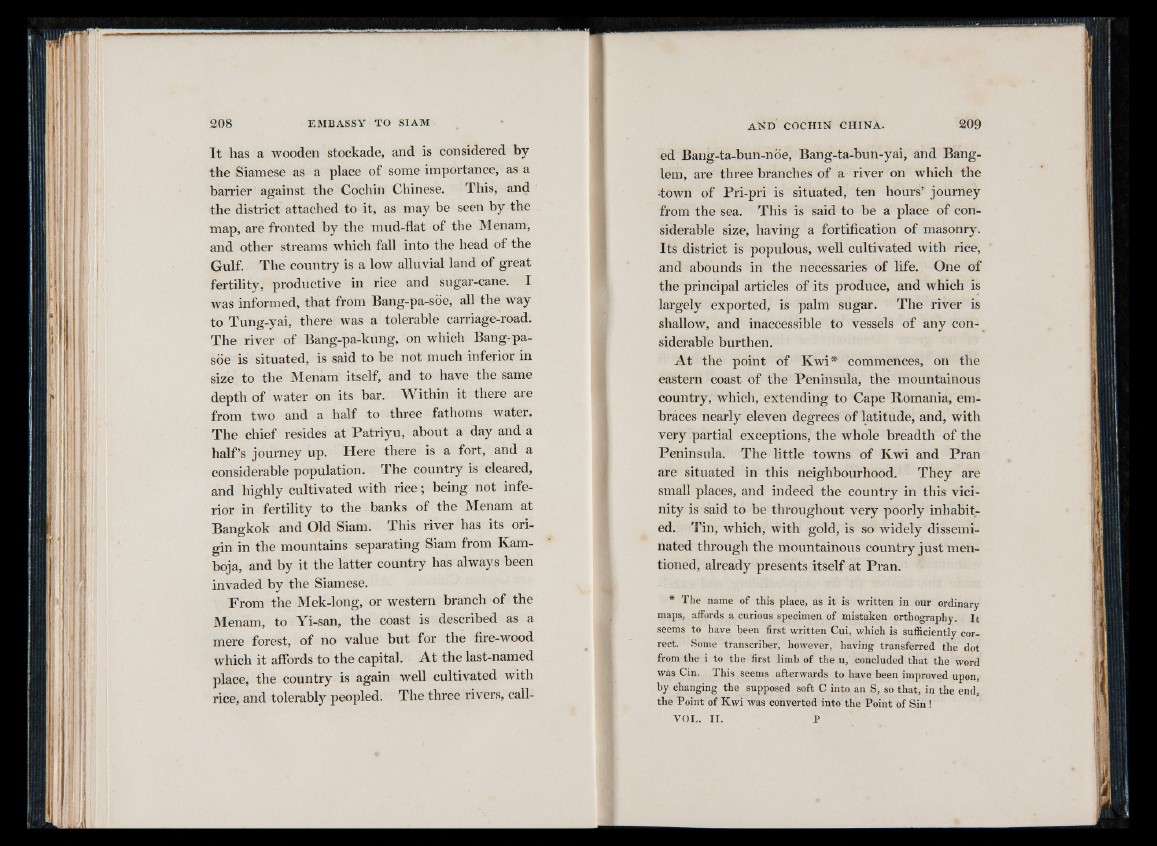
I t has a wooden stockade, and is considered by
the Siamese as a place of some importance, as a
barrier against the Cochin Chinese. This, and
the district attached to it, as may be seen by the
map, are fronted by the mud-flat of the Menam,
and other streams which fall into the head of the
Gulf. The country is a low alluvial land of great
fertility, productive in rice and sugar-cane. I
was informed, that from Bang-pa-soe, all the way
to Tung-yai, there was a tolerable carriage-road.
The river of Bang-pa-kung, on which Bang-pa-
soe is situated, is said to be not much inferior in
size to the Menam itself, and to have the same
depth of water on its bar. Within it there are
from two and a half to three fathoms water.
The chief resides at Patriyu, about a day and a
half’s journey up. Here there is a fort, and a
considerable population. The country is cleared,
and highly cultivated with rice; being not inferior
in fertility to the banks of the Menam at
Bangkok and Old Siam. This river has its ori-
o-in in the mountains separating Siam from Kam-
boja, and by it the latter country has always been
invaded by the Siamese.
From the Mek-long, or western branch of the
Menam, to Yi-san, the coast is described as a
mere forest, of no value but for the fire-wood
which it affords to the capital. A t the last-named
place, the country is again well cultivated with
rice, and tolerably peopled. The three rivers, called
Bang-ta-bun-noe, Bang-ta-bun-yai, and Bang-
lem, are three branches of a river on which the
town of Pri-pri is situated, ten hours’ journey
from the sea. This is said to be a place of considerable
size, having a fortification of masonry.
Its district is populous, well cultivated with rice,
and abounds in the necessaries of life. One of
the principal articles of its produce, and which is
largely exported, is palm sugar. The river is
shallow, and inaccessible to vessels of any considerable
burthen.
A t the point of Kwi* commences, on the
eastern coast of the Peninsula, the mountainous
country, which, extending to Cape Romania, embraces
nearly eleven degrees of latitude, and, with
very partial exceptions, the whole breadth of the
Peninsula. The little towns of Kwi and Pran
are situated in this neighbourhood. They are
small places, and indeed the country in this vicinity
is said to be throughout very poorly inhabited.
Tin, which, with gold, is so widely disseminated
through the mountainous country just mentioned,
already presents itself at Pran.
* The name of this place, as it is written in our ordinary
maps, affords a curious specimen of mistaken orthography. It
seems to have been first written Cui, which is sufficiently correct.
Some transcriber, however, having transferred the dot
from the i to the first limb of the u, concluded that the word
was Cin. This seems afterwards to have been improved upon,
by changing the supposed soft C into an S, so that, in the end,
the Point of Kwi was converted into the Point of Sin !
VOL. I l l P